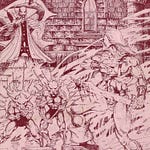White Dwarf Issue #6, published Apr/May 1978, marks a transitional phase for the magazine, reflecting its growing ambition and the evolving landscape of tabletop roleplaying games. Ian Livingstone’s editorial sets the tone by announcing significant changes; a relocation to Hammersmith, a subscription price increase to offset rising production costs, aesthetic upgrades like justified text and the introduction of full colour covers, and the introduction of a man who would soon become a legend in the genre, Mr John Blanche. These shifts underscore Games Workshop’s commitment to professionalism while acknowledging the challenges of sustaining a niche publication. Livingstone’s emphasis on reader feedback and openness to contributions highlights the magazine’s grassroots origins, even as it seeks to expand its reach. The editorial’s blend of optimism and pragmatism mirrored broader tensions in the RPG community between adapting to commercial realities and maintaining creative authenticity.
Roger Musson’s Combat and Armour Class article exemplifies White Dwarf’s focus on refining game mechanics. Musson critiques the simplistic armour class (AC) system in D&D, proposing nuanced categories like Target Armour Class (for missile attacks) and Prone Armour Class (for unconscious characters). His suggestions, such as tying AC improvements to character level and introducing fatigue rules, aim to inject realism into combat. While innovative, the complexity risks alienating casual players, particularly with concepts like monks’ AC progression. Whilst systematic it is rather dense and Roger’s theoretical framework may have limited practical adoption without streamlined examples.
The Fiend Factory, curated by Don Turnbull, remains a standout feature, showcasing reader-submitted monsters that balance creativity and playability. This issue introduces the Aspirin (a pine needle-infused zombie) and the Nilbog (a chaos-inducing goblin that gains hit points when struck). Turnbull’s editorial guidelines emphasising coherence, deployability, and humour elevate the column beyond mere novelty. The Disenchanter, a camel-like beast that drains magic items, stands out for its disruptive potential in campaigns. However, some entries, like the Throat Leech, prioritise gruesome flavour over mechanical depth, reflecting the column’s imaginative yet uneven ethos.
John Norris’ Figures Review of Archive Miniatures offers a pragmatic assessment of 30mm fantasy models, contrasting them with competitors like Der Kriegspielers. Norris praises the range’s diversity, particularly the Middle Earth themed figures, but critiques the soft metal casting’s blurred details and high import costs. He effectively bridges consumer advice and hobbyist enthusiasm, noting how figures like the dungeon equipment mule or the Umber Hulk enhance narrative immersion. However, the review’s focus on technical specs over gameplay integration feels detached from the magazine’s core RPG audience, revealing a latent tension between RPG communities and miniature wargamers.
The Traveller review by Don Turnbull dissects the nascent sci-fi RPG, from Game Designers Workshop, with a mix of admiration and scepticism. Turnbull lauds the game’s economic trade mechanics, intricate character creation system, and vector-based starship combat creating a compelling framework for interstellar campaigns. However, he questions its viability due to the referee’s overwhelming burden of universe building and the absence of alien intelligence rules. Compared to Metamorphosis Alpha’s confined generational ship setting, Traveller’s boundless scope is its greatest strength and weakness, appealing to hardcore enthusiasts while deterring casual players. Turnbull’s critique anticipates the game’s niche appeal, foreshadowing its eventual cult status.
Additional articles enrich the issue’s value. Treasure Chest introduces whimsical magic items like the Millennium Blade (summoning berserkers) and the Crystal Fount (boosting attributes at a cost), blending utility with risk. The Open Box section reviews Knights of the Round Table and Elric, praising the latter’s innovative card-driven gameplay while critiquing its reliance on luck. Letters from readers spanning debates over dice rolling autonomy and the divisive Kalgar comic strip reveal a community grappling with identity, torn between narrative freedom and tactical rigour.
In retrospect, White Dwarf Issue #6 captures a moment of maturation. Its blend of critical reviews, house rules, and monster design cements its role as a hub for RPG innovation, even as editorial choices like the aesthetic shifts and price hike signal a departure from its DIY roots.












Share this post